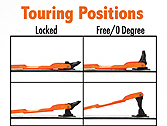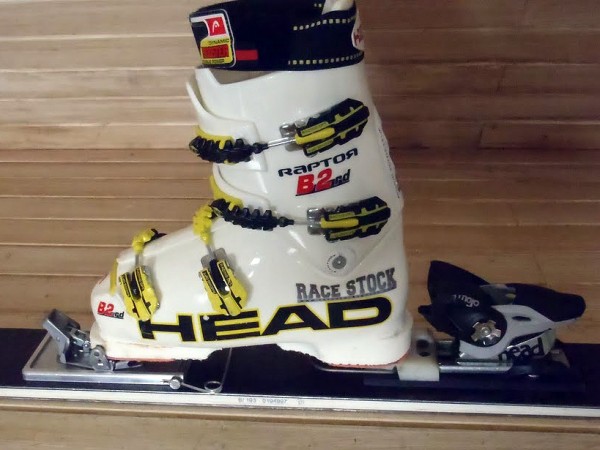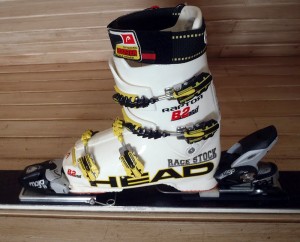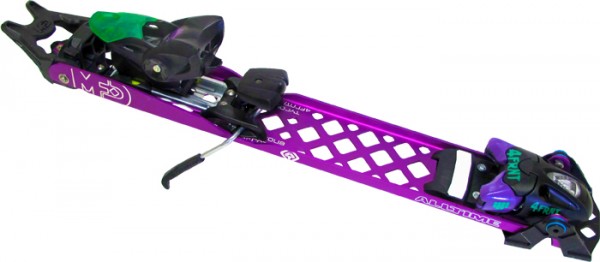It’s pretty interesting to see how things are progressing in the AT binding market, especially in the big and beefy realm where skiers want the upmost level of downhill performance, security and boot retention. I’m quite happy and content with tech style bindings (in which nearly all models are based on the Dynafit binding design), light and stiff boots with a large range of motion in the cuff, and light, but fat, skis paired with mohair skins. However, there are some people out there that want/need more in their backcountry skiing setup and there are a couple new players in the industry worth noting.
First off, there is the MFD All-Time skiing binding developed by Jason Prigge, which consists of an aluminum plate that attaches to your ski at the front with a hinged mount and has a heel lock/climbing bar block at the heel. A simple design, really, and more-or-less lets the skier use all the ski gear they already own. Just slap the plate between your skis and alpine bindings, throw on your rigid downhill boots and you are good to go.
 The MFD All-Time sells for $299 and comes in two models, one for use with Salomon and Atomic bindings, and another for Rossignol and Look binders. The simplicity of Jason’s creation is nice and IMO it’s technically more of an AT conversion plate, than a full on AT binding. The up-side of the MFD All-Time is that it has the “lowest standing height of all high DIN AT bindings†(not sure what the criteria is for that claim). However, the downside is that the pivot point appears to be located well in front of the mounted toe-piece and location of the skier’s toe. Combine this with the fact that with each and every step you have to lift an entire alpine binding, it sure seems like one would get fatigued pretty darn quick. I guess one could write it off as “trainingâ€â€¦right?
The MFD All-Time sells for $299 and comes in two models, one for use with Salomon and Atomic bindings, and another for Rossignol and Look binders. The simplicity of Jason’s creation is nice and IMO it’s technically more of an AT conversion plate, than a full on AT binding. The up-side of the MFD All-Time is that it has the “lowest standing height of all high DIN AT bindings†(not sure what the criteria is for that claim). However, the downside is that the pivot point appears to be located well in front of the mounted toe-piece and location of the skier’s toe. Combine this with the fact that with each and every step you have to lift an entire alpine binding, it sure seems like one would get fatigued pretty darn quick. I guess one could write it off as “trainingâ€â€¦right?
Another new option for those that want to lug their alpine gear up the hill is a company/product called Green Mountain Freeride AT. This is an interesting concept and again, is very simple. The Green Mountain Freeride AT system basically consists of hinged plates that are swappable for when you are on the up and down. For the up, you mount the plate that is mounted with your tech binding toe piece. For the down, swap that plate out for one that is mounted with your alpine binding toe piece. Wait…there’s more!

Green Mountain Freeride AT plate system.
The Green Mountain Freeride AT System also comes with climbing bars and a heel block, as well as an allen head screw that one can insert into the toes of their alpine boots to make them “tech binding†compatible. Since the skier is only using the tech toe inserts for skinning, the theory is that the strength of the boot toe-sockets doesn’t need to be as bomber as ones used for going downhill as well. That sounds logical, but I’d say the jury is out on the claim and I wonder if this is where the design will have problems.
 The upside of the Green Mountain Freeride AT compared to the MFD All-Time however is that not only is the toe pivot point closer to the boot toe, but neither the alpine toe or heal piece have to be lifted on every step, which is definitely a step in the right direction. There is an increased fiddle factor with the swapping in and out of the plates though, which could be tough when you friends are waiting to rip the powder. Currently, the Green Mountain AT is in a beta test phase, so we will see if it goes into full production.
The upside of the Green Mountain Freeride AT compared to the MFD All-Time however is that not only is the toe pivot point closer to the boot toe, but neither the alpine toe or heal piece have to be lifted on every step, which is definitely a step in the right direction. There is an increased fiddle factor with the swapping in and out of the plates though, which could be tough when you friends are waiting to rip the powder. Currently, the Green Mountain AT is in a beta test phase, so we will see if it goes into full production.
These new offerings are a step in the right direction for when “heavy is rightâ€, but sometimes I wonder if it is a good idea to have the beefiest ski/boot/binding combo when skiing in the backcountry. For instance, I feel like lighter gear sometimes acts at the defacto “head check†for doing stuff that is too bury, risky or dangerous when in the backcountry. It’s much easier to say, “Hell yeah, let’s stomp that 20 footer.†when you are skiing in your alpine rig verses your lightweight AT setup. Yet at the same time, cratering, cart wheeling and mashing your face into your knees are all quite possible and more likely from hitting that 20’ jump, than just happily skiing by it.
It is cool to see all the pros in the movies shred those sick lines at mach-schnell in AK, but should skiers be attempting that stuff at every backcountry zone in the lower 48? Unsupported by heli-crews ready to respond instantaneously? I don’t know…food for thought I guess.


its scary to get extreme in the backcountry, but sometimes it is appropriate. here is me airing and skiing fast on my “heavy rig”. however there is nothing here that my new dynafits and voiles cant handle….
These two systems both look rad! there’s definitely a place for heavy and beefy in the backcountry, the more options the better. i spend a lot of time on dynafits and 3-buckle boots, but also plenty on dukes and alpine boots.
The Green Mountain system is interesting and I like where they’re thinking, but I see one problem. I think that toe attachment strength is equally if not more important during skinning, because it is the exclusive attachment to the ski, and can be subjected to very high torque when switchbacking on firm snow. This is where a dynafit system seems to excel against duke/fritschi/etc, where the greater torsional rigidity allows holding a better edge. So, unless the allen screw tech attachment is BOMBER, it seems like you need tech-compatible boots anyway, in which case . . . why not FT-12 or Plum bindings?
MFD system looks interesting as well, obviously not a do-it-all solution, but allows skiing an alpine setup in a human-powered area. This opens up all sorts of fun and rowdy terrain outside of ski areas but worthy of a heavy setup if a skier is willing to carry the weight (as you point out, training!)
I think the most interesting development of late is the Bodacious ski boot, it appears to be a no-compromise alpine boot with tech fittings. In my mind, dynafits are plenty strong, it’s the boots that hold them back against a full alpine setup. Being able to ski an alpine boot in backcountry areas that are approachable with an alpine boot (aka no long, flat slogs where lack of walk mode will REALLY hurt) is an exciting possibility.
Anyway, sorry for the long post. Great time to be a skier, lots of new gear tech these days!
http://vimeo.com/29322256
….whether it is light or heavy, what really matters is having fun and a high psyche level!
MFD all the way! A little extra weight never hurt anyone in exchange for bomb proof binding protection. Lock it down, lose the frown!
I love MFDs. With steel Soly 916s is the ultimate La Grave setup!
I dig the colours of the alltime, I always knew it was only a matter of time till 90s style ski wear returns.
When Salomon finally gets around to releasing their touring binding, the duke will have meet it’s match. That’s really what were talking about here.
I love my dynafits for skinning around Togwotee pass, or carrying up the skillet, but the idea of a full on alpine binding that still skins is, in my mind, STILL an untapped market. I second Tucker’s observation, no way are screwed in fitting going to hold up to my less than gracefull kick turns. In fact, in certain hard snow situations a failure could be dangerous.
i have used the mfd for a yr now. finally a system for resorts like jackson and utah with open boundaries, where people dont have the money for 2-4 different skis and bindings. And you can send airs! out-abounds and right back in with the same skis. i have toured with them on long tours, and you can ski faster and harder. they might not be as light as dynafits, but they come down better. i prefer the salomon 14 din bindings, it keeps them a little lighter. you can buy a toe and heal piece, and just switch them to another ski if you like. then you dont have to buy another binding! not to mention a few props for a skier skid designing them. just giving people another option!
right on TAT! i will probably see you with those MFDs on albright this year.